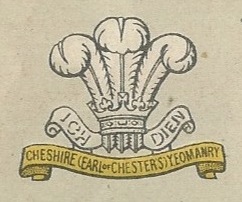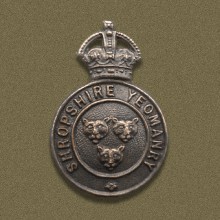
The 74th (Yeomanry) Division was a Territorial Force infantry division formed in Palestine in early 1917 from three dismounted yeomanry brigades. It served in the Sinai and Palestine Campaign of the First World War, mostly as part of XX Corps. In May 1918 it was sent to the Western Front where it remained until the end of the war.

The Norfolk Yeomanry was a volunteer cavalry (Yeomanry) regiment of Britain's Territorial Army accepted onto the establishment of the British Army in 1794. After seeing action in the Second Boer War, it served dismounted at Gallipoli, in Palestine and on the Western Front during the First World War. Between the wars it converted to the Royal Artillery (TA), and served as an anti-tank regiment in France, the Western Desert, Italy and North West Europe during the Second World War. After the war it served as a TA air defence unit and then as an Army Air Corps unit.

The 3rd County of London Yeomanry (Sharpshooters) was a Yeomanry regiment of the British Army. It was raised in 1901 from Second Boer War veterans of the Imperial Yeomanry. During the First World War it served dismounted at Gallipoli, was remounted to serve in Macedonia, Egypt and Palestine, before being converted to machine gunners for service on the Western Front. 2nd and 3rd Line units remained in the United Kingdom throughout.

The Cheshire Yeomanry was a yeomanry regiment that can trace its history back to 1797 when Sir John Leicester of Tabley raised a county regiment of light cavalry in response to the growing fears of invasion from Napoleonic France. Its lineage is maintained by C Squadron, the Queen's Own Yeomanry.

The Shropshire Yeomanry was a yeomanry regiment of the British Army, first raised in 1795, which served as a cavalry and dismounted infantry regiment in the First World War and as a cavalry and an artillery regiment in the Second World War. It was then amalgamated with the Shropshire Royal Horse Artillery.
The 3rd Mounted Division was a Yeomanry Division of the British Army active during World War I. It was formed on 6 March 1915 as the 2/2nd Mounted Division, a replacement/depot formation for the 2nd Mounted Division which was being sent abroad on active service. In March 1916, it was renumbered as the 3rd Mounted Division and in July 1916 as the 1st Mounted Division. In September 1917, the division was reorganized as a cyclist formation and redesignated as The Cyclist Division. It remained in the United Kingdom throughout the war and was disbanded in June 1919.
The 1st Mounted Division was a Yeomanry Division of the British Army active during World War I. It was formed in August 1914 for the home defence of the United Kingdom from four existing mounted brigades of the Territorial Force, each of three regiments of Yeomanry. The divisional order of battle changed often, as the 1st Line brigades left for service overseas and were replaced by 2nd Line formations. It was converted to the 1st Cyclist Division in July 1916, and was broken up in November 1916 without being involved in active service. It remained in East Anglia throughout its existence.
The Denbighshire Hussars was a Welsh Yeomanry regiment of the British Army formed in 1794. It saw service in the First World War before being converted into a unit of the Royal Artillery. The lineage has been continued by 398 Squadron, Royal Logistic Corps.
The Sussex Yeomanry is a yeomanry regiment of the British Army dating from 1794. It was initially formed when there was a threat of French invasion during the Napoleonic Wars. After being reformed in the Second Boer War, it served in the First World War and the Second World War, when it served in the East African Campaign and the Siege of Tobruk. The lineage is maintained by 1 Field Troop, 579 Field Squadron (EOD), part of 101 (London) Engineer Regiment (Volunteers).

The Lincolnshire Yeomanry was a volunteer cavalry unit of the British Army formed in 1794. It saw action in the Second Boer War and the First World War before being disbanded in 1920.

The Queen's Own West Kent Yeomanry was a British Army regiment formed in 1794. It served in the Second Boer War and the First World War. It amalgamated with the Royal East Kent Yeomanry to form the Kent Yeomanry in 1920.
The West Somerset Yeomanry was a Yeomanry regiment of the British Army. First raised in 1794, it participated in the Second Boer War and World War I before being converted to an artillery regiment. It served in World War II. Post-war it was gradually reduced in strength until the yeomanry lineage of the successor unit was discontinued on 9 November 1988.
The Welsh Horse Yeomanry was a yeomanry regiment of the British Army that served in the First World War. The regiment was raised shortly after the outbreak of the war. Initially it served in East Anglia on anti-invasion duties, before being dismounted in 1915 and sent to take part in the Gallipoli Campaign. After withdrawal to Egypt, it was amalgamated with the 1/1st Montgomeryshire Yeomanry as the 25th Battalion, Royal Welch Fusiliers and served as such throughout the rest of the war. It took part in the Sinai and Palestine Campaign in 1917 and 1918, before being transferred to the Western Front where it remained until the end of the war. The regiment formed 2nd and 3rd Lines in 1914, but these never left the United Kingdom before being disbanded in 1916 and early 1917, respectively. The 1st Line was disbanded in 1919.
The Royal North Devon Yeomanry was a Yeomanry regiment of the British Army. First raised in 1798, it participated in the Second Boer War and the First World War before being amalgamated with the Royal 1st Devon Yeomanry in 1920 to form the Royal Devon Yeomanry.

The 231st Brigade was an infantry brigade of the British Army that saw active service in both the First and the Second World Wars. In each case it was formed by redesignation of existing formations. In the First World War, it fought in Palestine and on the Western Front, while during the Second World War it served in the Allied invasion of Sicily, Italy and the Normandy landings of 6 June 1944.

The 2nd Dismounted Brigade was a formation of the British Army in the First World War. It was formed in Egypt in February 1916 by absorbing the Highland Mounted Brigade and the 2nd South Western Mounted Brigade. In October it absorbed the remnants of the 1st Dismounted Brigade. The brigade served as part of the Western Frontier Force and the Suez Canal Defences.

The 3rd Dismounted Brigade was a formation of the British Army in the First World War. It was formed in Egypt in February 1916 by absorbing the Eastern Mounted Brigade and the South Eastern Mounted Brigade. The brigade served as part of the Western Frontier Force and the Suez Canal Defences.

The British yeomanry during the First World War were part of the British Army reserve Territorial Force. Initially, in 1914, there were fifty-seven regiments and fourteen mounted brigades. Soon after the declaration of war, second and third line regiments were formed. However, the third line regiments were soon absorbed into the Cavalry Reserve Regiments, to supply replacements for the cavalry and yeomanry. Other horsed regiments in the British Army, during the war, were the regular cavalry regiments and the three regiments belonging to the special reserve: the North Irish Horse, the South Irish Horse and the King Edward's Horse. The senior yeomanry regiments could trace their origins back over 100 years; the oldest regiment, the Royal Wiltshire Yeomanry, had been formed in 1794. The most junior regiment, the Welsh Horse, had only been formed on 18 August 1914, after the start of the war.
The Royal 1st Devon Yeomanry was a Yeomanry regiment of the British Army. First raised in 1794, it participated in the Second Boer War and the First World War before being amalgamated with the Royal North Devon Yeomanry in 1920 to form the Royal Devon Yeomanry.
The 17th Mounted Brigade previously known as the 2/1st Welsh Border Mounted Brigade was a 2nd Line yeomanry brigade of the British Army during the First World War. In July 1916 it was converted to a cyclist formation as 10th Cyclist Brigade and in November 1916 was redesignated as 6th Cyclist Brigade. It was still in existence, in Ireland, at the end of the war.











